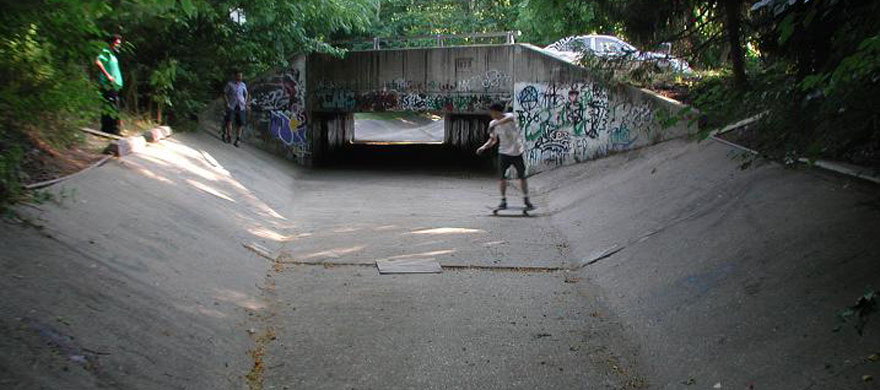
I have a theory that you can never truly know a place unless you grow up there. I know this is not a particularly original idea, in fact I think I may have first encountered it in print in an old Stephen King novel, but it’s still an idea I developed independently so I’m laying claim to it. I think I first formalized this theory during my freshman year at college. I had moved out of state for school and that first year I did a fair amount of late night wandering around the surrounding neighborhoods. I quickly realized how little I knew about where I now lived. Live somewhere long enough as an adult and you can become familiar and comfortable with the area, but it will never be the same as where you were raised. The continuous exploration that is such a fundamental part of childhood gives an intimate knowledge of the territory that cannot be replicated later in life. This exploration begins in the home before slowly expanding outwards in an ever-increasing radius, a logarithmic spiral, as the child becomes more mobile and the ranging area expands.
Digging around in our basement one winter I found the hidden Christmas presents and subsequently ruined the myth of Santa Claus for my younger sister. I was in the backyard of almost every house in the neighborhood, jumping fences for “shortcuts”. A group of us found a way up on to the elementary school roof. Why, I don’t know? We figured out how, so, like Everest, we climbed it simply because it was there. Any small overgrown vacant lot or patch of trees was a forest to explore. New homes or other buildings under construction were routinely broken in to, not so much for petty theft or minor vandalism (though those two often accompanied it) but because the temptation to see what was inside was irresistible.
I grew up in the immediate northern suburbs of Baltimore, a quintessentially suburban area that would be instantly familiar to anyone from a similar environment. Baltimore is encircled by a beltway and roughly bisected by the Jones Falls Expressway, which becomes I83 as it continues north into Pennsylvania. A main road lined with chain stores and strip malls ran parallel to that highway and my house sat one block off that road, almost in sight of the junction of the Beltway and 83. I say almost in sight because there was a small ridge in the way. Growing up, that ridge was home to a drive in movie theater and from my sister’s bedroom window you could see fragments of the screen. I spent many hot summer nights trying in vain to watch what was playing. That drive in was later replaced with a mirrored glass clad office building where my childhood friend Joe worked, if not still works.
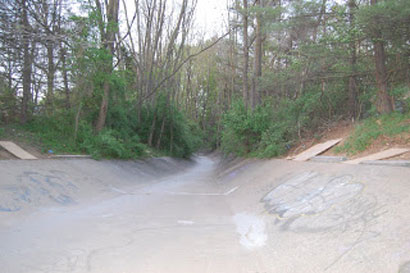
The Ditch looking east. Source: The Adventures of Gnarly Carleigh
A few years ago, home for the holidays and going a bit stir crazy one afternoon, I went for a long walk. I found myself on the far side of the railroad tracks, very near that office building. I was still relatively close to my parent’s house but many blocks out of the way if I followed the roads home. I decided to take the shortcut through the woods. The path that I remembered was still there, overgrown but passable. The skeleton of the half-finished mini-ramp that we had discovered as children (and made grand plans to finish that never materialized) was also still there, though nature had begun to reclaim it. There was a small stream that was harder to cross than I had expected. The banks were muddy and steep and took a bit of scrabbling to get up the hill to the track bed. Once across the tracks, the quickest way home was then to walk past the loading docks behind a strip mall, jump a fence and then climb a path up a long steep hill to the main road. This is not how adults get around in the suburbs and I’m sure I raised a few eyebrows. Even seeing adults walking around my parent’s neighborhood is still something of a rarity, much less pushing through brambles, fording streams, jumping fences and climbing hills, yet I grew up there. That was how you did it as a child. That was the proper way home.
It was at Joe’s house that I first stepped on a skateboard, an old yellow banana board we found in his basement. Joe lived directly across from the elementary school, less than a half mile from my house. Down one shaded block of old growth oak trees and older homes, through a block of newer, nearly identical, post war houses (where my friend Eddie lived) and up a small rise before dropping down one final block to the elementary school. I used to stop at Joe’s after school to play with his action figures or look at his comic books. Along with Dungeons and Dragons and science fiction novels those were my interests at the time. Not that I wasn’t physically active. My parent’s approach to childhood development had been to throw everything at us and see what stuck. Both my sister and I took a variety of lessons and played a wide range of sports. I wasn’t particularly clumsy but I also didn’t have much in the way of natural talent. I was never going to be an athlete. My interests were leaning much more towards art and the typical “indoor kid” pursuits until I found skateboarding. Two neighborhood boys, Eddie and Brian had started skating slightly before I did and because of them my parents had already asked if I would want a skateboard. I had declined the offer but after playing with the board at Joe’s house and feeling a natural affinity towards it, I changed my mind. I have no idea what brand my first deck was, though I can still picture it. It was just a generic board from the local department store, not even a Nash Executioner, though it did have a dragon on it.
“Two hundred years of American technology have unwittingly created a massive cement playground. It took the minds of 12 year-olds to realize its potential.”
Craig Stecyk quoted in the beginning of Future Primitive.
At its essence, skateboarding is a child balancing on a wheeled piece of wood and yelling, “look what I can do!” What comes next is that without any real forethought, “look what I can do” becomes, “I wonder if I can do that on this thing over there”. It is now a truism that “skateboarders look at the world differently” but back then the idea seemed revolutionary. The aimless childhood exploration became purposeful exploration. We spent all day scouting unfamiliar neighborhoods looking for the happy accidents of the man made environment, especially focusing on the ignored infrastructural and interstitial industrial spaces ripe for repurposing. The best of these became named, they became “spots”. California had empty pools. The Baltimore suburbs had the Ditch and the Ditch was my first “spot”.
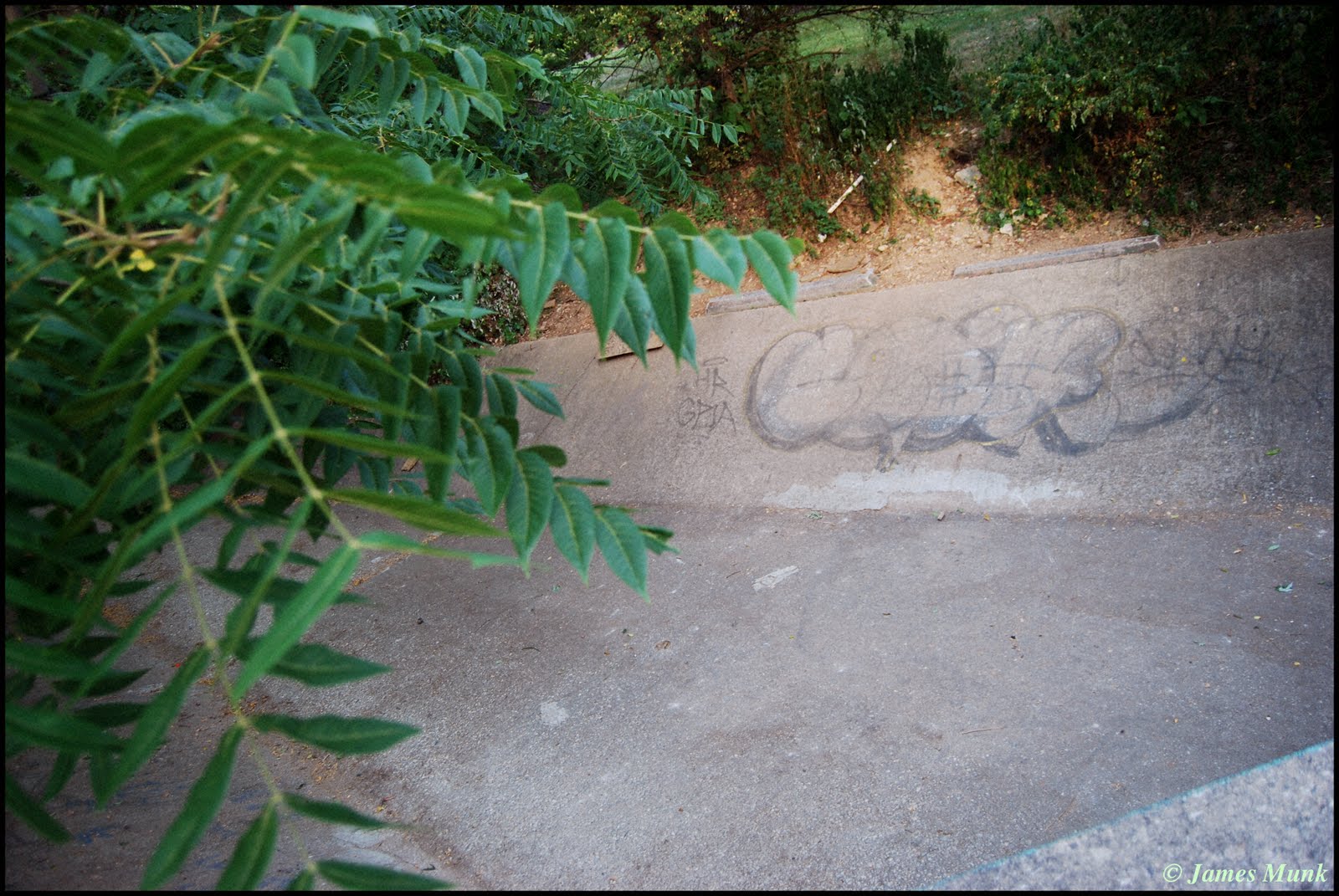
The Ditch from above. Source: Munksauce
We had actually found the Ditch well before we started skateboarding. Adjacent to the elementary school was a cul-de-sac and behind that cul-de-sac a large storm drain emptied into a small ravine. “Ravine” is almost definitely too generous a description. Seen today I would be surprised if it was deeper than five feet, but to us, as children, it was massive. We played there often. It was the site of much climbing and faux-rappelling. In that strange oral history of children it was named Deadman’s Ditch for reasons forever lost to time. The storm drain that opened into the ditch was large enough for us to enter it only slightly hunched. Legend had it that the older boys in the neighborhood had a fort farther back inside, complete with lawn furniture and porn magazines, where they would smoke weed. I was never able to verify any of that because, even armed with flashlights, we lost our nerve after venturing only a short way up the tunnel. What I do know is that one day while playing there, a bunch of older boys burst forth from the tunnel and set upon us. What followed was a lot of hooting, hollering, stick bashing and bikes thrown down the ravine while we younger children scattered. I can only imagine that it must have looked like primate warfare from an adult perspective. It was all so uneventful in the end. No one was hurt and we all slunk back later to retrieve our bikes but I still remember how terrifying it was. There was something so feral about childhood. We lived in fear of those older bullies for years.
A narrow strip of trees, or “woods” in our suburban parlance, bordered the small stream that was fed by the runoff from the tunnel. These “woods” extended behind the elementary school and effectively separated my neighborhood from the apartment and condominium complex behind it. Except in times of heavier rain, this stream generally dried out by the time it reached the concrete drainage ditch near the eastern entrance to the apartment community. That drainage ditch at first inherited the name of the ravine, it was just a continuation of Deadman’s Ditch to us, but once I was skating and meeting other people from outside the area, I found that they called it Pot Springs Ditch, named for the road that passed over it. We eventually just shortened that to “The Ditch”. Most of it was a small, tight ditch, possible to skate as a snake run but not much else. We would try to treat it like our own personal Wallows but the angles were too steep and the flat too short to really do much with it. It widened and mellowed where it crossed under Pot Springs Road before narrowing again and winding through the emerald manicured lawns of a much wealthier community, eventually joining a proper stream that flowed into Loch Raven Reservoir.
Skateboarding was weird in 1985. It was incredibly popular but no one I knew really knew how to skate. The first summer that I skated, it was mostly what I term “little kid skating”, something that is instantly recognizable to this day. It generally features a kicking out of the board, a bunch of random flailing of limbs and then turning to a friend and loudly saying, “Did you see that! I almost did a 540!” It is still just, “look what I can do”. The next step is when it stops being just play and becomes actual attempts to learn tricks through massive amounts of sometimes extremely frustrating repetition. Street skating was in its infancy and was not really codified yet and there was a brief and confusing period where we were as “good” as the pros. We weren’t really as good as someone like Tommy Guerrero for example. We weren’t as fast or as stylish and couldn’t do things as big as he could, but we could do all the tricks. We were at least as “good” as the street skating in Future Primitive. It wasn’t really until Public Domain that we truly began to be outpaced. Most of the street skating footage we saw at the time was from contests, where the remnants of the old 70’s “street style” skaters were now competing against shirtless punks jumping off cars. The magazines and videos of the day were filled with vert skating and as east coast suburban kids we didn’t have access to anything like that. We tried to emulate those tricks on the street. We did early grab airs out of curb cuts, bonelesses, acid drops and street plants.
A large amount of product fetishism accompanied the fad. We were all poseurs. There were must have decks, such as the Powell Peralta Tony Hawk or the Vision Gator. We wore brightly colored, checkered slip on Vans and floral Jams or velcro-ed Jimmy’z. We girded our decks with every conceivable protection device, padding them out like football players with skid plates, noseguards, rails, copers and lappers, the brighter the colors the better. I had neon green grip tape on my department store board that I had, by then, spray-painted neon orange. The 80’s weren’t known for their understatement, more was always better. I would not be exaggerating if I said that close to half of the boys in my 6th grade class skateboarded. By the 8th grade the fad had started to pass and the numbers had been whittled down to the true skaters, those that would skate for at least the rest of high school. The Ditch was largely responsible for this transformation in me, from fad follower to someone who identified as a skateboarder. It was the first real “spot” I ever skated, the first place I ever felt like a real skater.
There were wider sections of the Ditch on both sides of Pot Springs, with a low, square, graffiti filled tunnel passing under the road. Judging by that graffiti (Sabbath, pentagrams, swastikas, weed and dicks if memory recalls) this had been a hang out spot long before I found it. I can only guess that it had been skated since the 70s if not earlier. That is a story for one of the east coast pioneers to tell, some brave soul on a piece of wood with roller skate wheels decided to try to roll down the damned thing (Ed. note, it was Denny Riordon!). By the mid ’80s it was a spot that people from surrounding areas traveled to skate. We skated the western side. By later in high school, the skating had shifted to the eastern side, probably because that side had more trees, was more concealed from traffic and was therefore less likely to attract the attention of a random passing cop. The eastern side was a mirror of the western side, in fact, it may have even been wider for longer, but to me the “proper” side is always going to be the west. As I said before, here the ditch widened, flared is a more accurate description, going from the narrow steeper section to a much wider flat section with mellower banks as it approached the bridge. The dirt along the edges of the lip was dug out so you could grind and, as I will always remember it, it had random pieces of wood lying along the top, to give you more roll in speed. Opposite these would be partially sunken parking blocks, emulating coping. Against the bridge it banked slightly to the wall, allowing for awkward wall rides. It wasn’t easy to skate. The surface was rough, there was an abrupt transition from the flat to the banks and it was very difficult to keep your speed up. My friends didn’t like it. I did and I often went alone. I wasn’t really allowed to, it being “illegal” and a hangout spot for older burnouts and other suburban malcontents, but like much of skating at that age, once I was out of the house I did as I pleased.
What I liked so much about the Ditch was that it offered me a taste of what ramp skating must be like. I would imagine myself taking a run on a half pipe, pretend that I was a pro skater and try to mimic all the tricks I had seen in print or on video. Of course I couldn’t skate it like that initially but I do remember when I learned. One day I went alone. The Ditch was normally empty and I often had it to myself. That day there was an older boy there. He was probably only in high school but he seemed like an adult to me. He was vaguely punk (“hesh” in current skater jargon) in complete contrast to my day-glo 80’s little kid style. He intimidated me. He was much better than I was but he was friendly and he taught me quite a lot. He showed me how to skate the Ditch like a ramp, not that I could immediately do it, but his advice lead to me learning all the basic lip tricks on the parking block. Things such as axle stalls, disasters and rock n rolls, as well as slashing grinds and small frontside ollies, moves that gave lateral motion, instead of the “square” back and forth, and that allowed you to pick up much more speed. He also told me that if I wanted to skate seriously I had to ride Indys, because, I kid you not, I think I had pink Gullwing trucks at this point. That is a lesson I still heed to this day that is how important it was. When I bought a board again after about 20 years of not skating, I had no idea what kind of deck or wheels I should buy, but I knew I had to get Indys.
I became a local at Ditch. It was my spot for about a year or two. I was better there than many of my friends because I skated it so often. I vividly remember how cool I felt when I would land a trick that was at a next level of progression. A smith grind across the length of the parking block, or a wall ride to board slide off the edge of the wall to back in fakie. We would tell the little kids we were pros, passing older teens would harass us; cops would sometimes stop and chase us out. Occasionally there would be older, better skaters there but in general it was a kingdom of 12 year old boys. I think it was (and is) so important to me because it was mine. I found it. It wasn’t a spot that I heard about via word of mouth. It wasn’t something built for us or that we built. It was something that was essentially in my backyard that I adapted to skateboarding, that allowed me to see the potential of skateboarding.
The extraneous accessorizing passed as middle school advanced. The grip tape became black and the clothing more understated. I eventually stopped skating the Ditch very often, more because of changing fads and increasing opportunities than for lack of interest. It remains in my mind as the most formative spot of my youth and it’s a shame I don’t have any pictures or video from back then. I’ve included some of what I have found online. The wallride is the only contemporaneous picture. There are also a few random clips on YouTube that I will include below. I hope to skate it again soon and get my own pictures and video. I imagine it will completely suck and I will hate it but it was the best thing going for a year or two in the mid 80s and I’m sure it’s still a popular spot for the neighborhood kids.

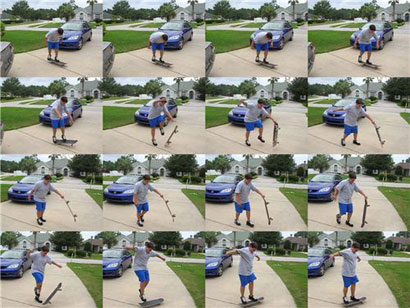
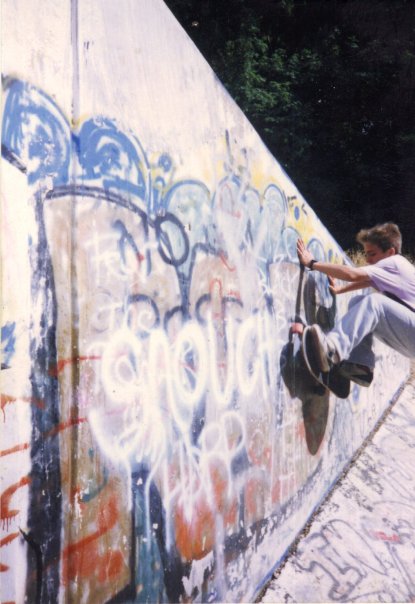
I’ve really enjoyed your writing, Pat. It’s like I’ve just relived one of the happiest parts of my childhood all over again, thanks to you.
When I knew you at Hunts I had no idea that you had been into skating, let alone skated at the same spots that I did. Anyway, thanks again.
BTW – I was once told that the name Deadman’s Ditch came from some dude who died after he launched his motorcycle off into it. I’m not sure how true the story was but the name obviously stuck. I also remember how hot the mulch was if you dug into it (since it was decomposing).
Where exact is it? I looked on google maps at Pot Springs Road and don’t see it. I am new to the state, so any other cool spot if anyone knows, please share. Great article.
Just south of Deer Fox Ln.
I love this writeup. The exploration done as kids is so relatable. That spirit of seek-and-skate never really leaves you. We found a concrete bowl deep in the woods in NJ as young skaters in the 80s, but we sadly never got to skate it due to it always being full of murky water. It was a regret that I strangely carried with me long after I stopped skating. 30+ years later, I couldn’t take it any longer. I hiked back there, drained it out, and skated it once and for all this past winter. So gnarly, so hard to skate. Absolutely worth it.
I remember riding bikes in The Ditch back in the early 70s. We had no clue what skateboarding was until later.
And yes…back then it wasn’t unusual to find Playboy and Penthouse mags.
Never forget my older sister caught me reading a discarded Penthouse there.
I don’t remember anyone ever calling it Dead Man’s ditch.
It was always just The Ditch to us.
Good times with fun kids.
Banana seats still rule!